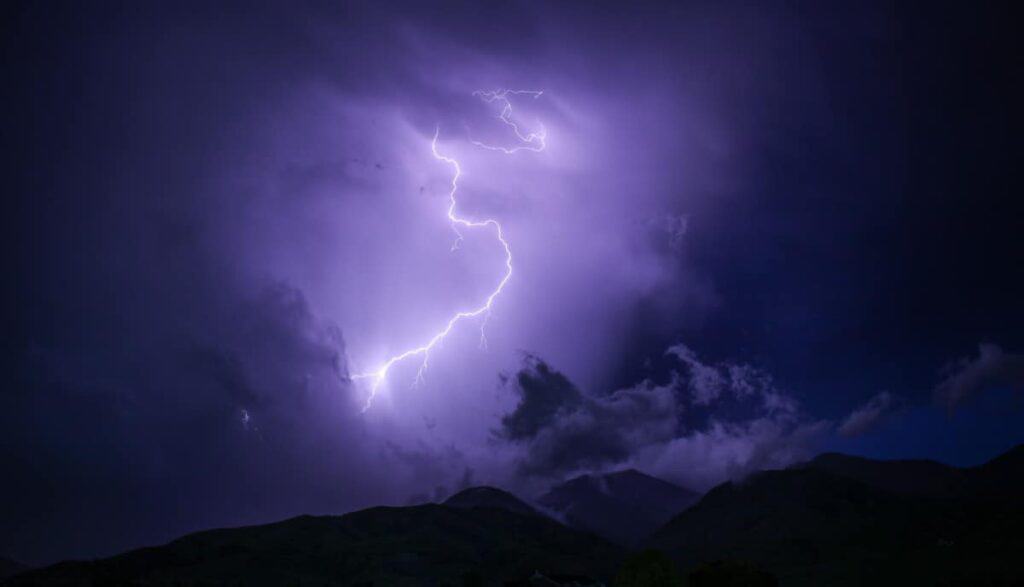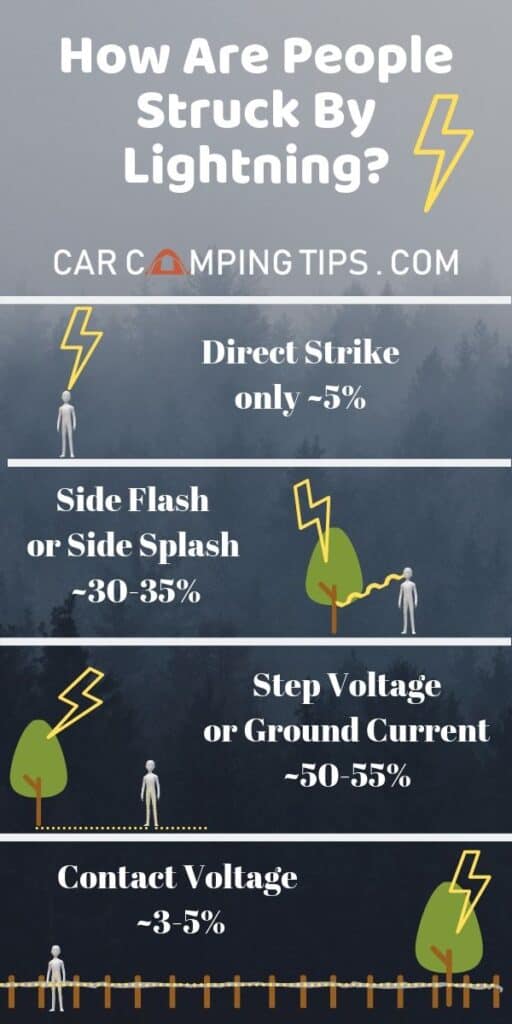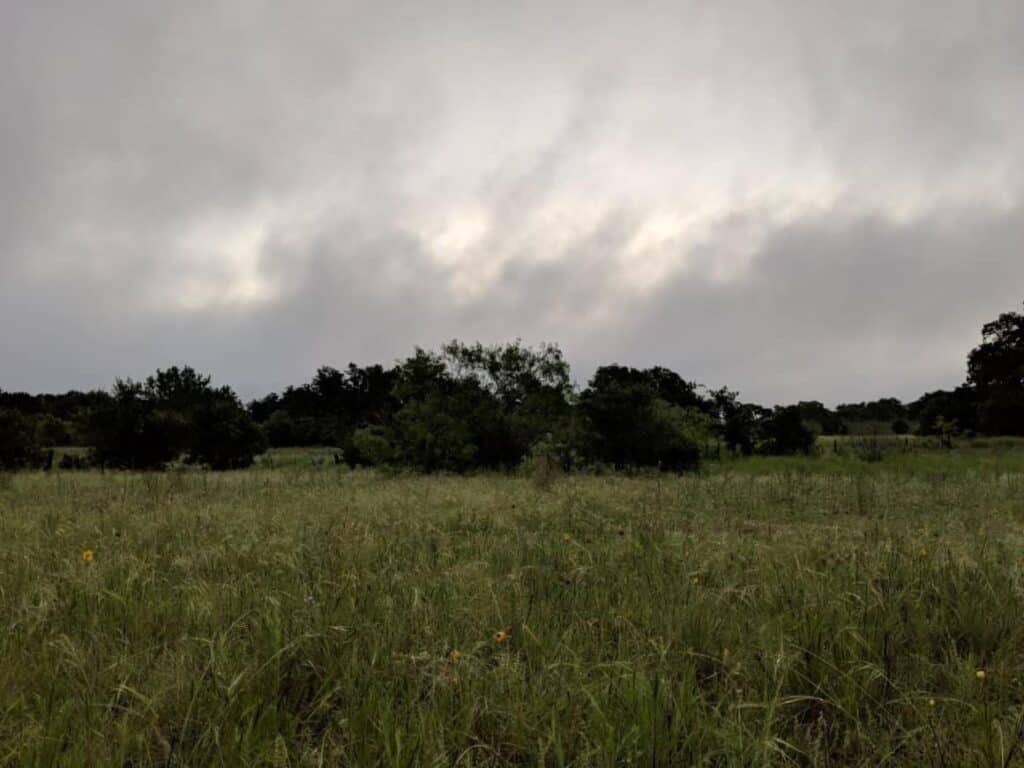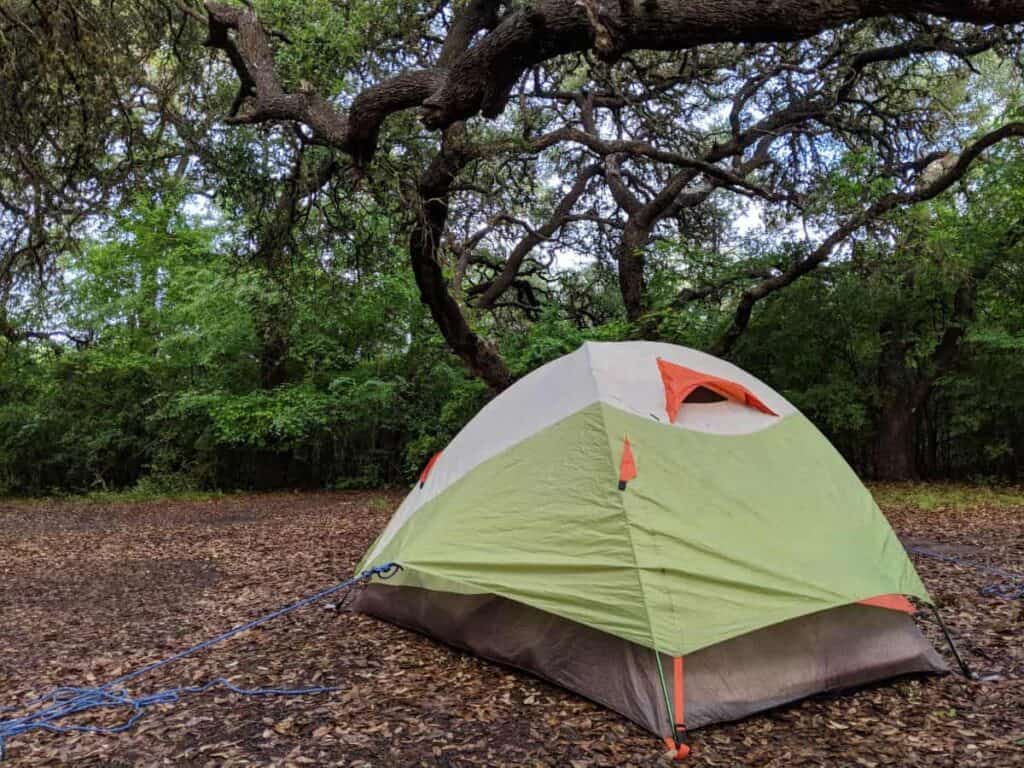Boom!

Always a scary sound when you’re camping. You’re hunkered down in your tent, the rain is pouring down on your tarp making a deafening pattering sound, and you’re probably wondering:
Am I safe from lightning while in my tent? Being in a tent offers no additional protection from lightning, even though you are protected from the rain. Fortunately, there are many options to help you stay safe if you’re caught in a thunderstorm, including avoiding open spaces, avoiding lone tall objects and the tallest trees. If you’re at a campground or car camping then retreating to your car or to a plumbed building will help you stay safe.
By the way, as an Amazon Associate, I earn when buying qualified products through links on my site.
- Dangers of Thunderstorms While Camping
- What Does It Mean To Be Struck By Lightning?
- Staying Safe During a Thunderstorm While Camping
- Tents and Thunderstorms FAQ
Dangers of Thunderstorms While Camping
Before we jump into ways to stay safe during a thunderstorm while you’re out in nature, let’s dive into trying to understand what the risks actually are and if it’s actually something to be concerned about.
Dangers of Thunderstorms While Driving
It’s easy to dismiss thunderstorms while driving because you’re in a secure vehicle–however, there is actually a lot of risk that you might now know about. I talk about some interesting driving and thunderstorm facts (as well as some tips on how to stay safe) in my article, here.
Dangers of Rain While Camping
From the NCHS, available at the CDC’s website, the number of rain-related deaths was the following:
| Cause of Death | Number of Deaths in 2017 |
| Exposure to Excessive Natural Cold | 804 |
| Cataclysmic Storm | 132 |
| Flood | 27 |
| Lightning | 19 |
Because rain comes with thunderstorms, it’s inevitable that some terrain, such as canyons, and valleys can experience flooding, or even flash flooding (flooding with almost no warning). Aside from the flooding danger, as any experienced backpacker knows, staying dry becomes massively important when you’re hiking for a long period of time.
Not only do wet shoes encourage blisters, but rain, especially in the mountains, can encourage hypothermia. Exposure to cold is much riskier than anything else mentioned in this article. Your ability to stay warm is highly correlated with your ability to stay dry in the wilderness.
Dangers of Lightning While Camping
Although we are the least likely to be hurt by lightning than by all the other calamities mentioned in this article, it’s by far the most gripping and scary part of a thunderstorm.
Consequences
The consequences of being struck by lightning are severe.
According to the NOAA, noted below, 10% of people suffering from a lightning strike die. So your chances are good that you’ll make it through if you get struck by lightning.
However, the side effects can affect the quality of life dramatically. People can experience seizures, heart problems, memory loss, and other several neurological issues including coma. The most common and severe side effects though are cardiac (heart) related. (source) Many of these side effects stay with lightning victims for years, if not the rest of their lives.
Odds of Being Struck By Lightning While Camping
Although we know better what amount of people die from lightning strikes each year, we know less about those who have been struck by lightning and survive.
The NOAA states that an average of 27 deaths occur in the United States every year, and estimate that only 10% of lightning strikes occur in death, therefore, 243 people are non-fatally injured by lightning every year.
The NOAA furthermore divides that number by the US population, which brings the odds to 1 in 1,222,000. Averaged across a lifespan of 80 years, the odds are now 1 in 15,300.
1 in a million makes you feel relatively safe, but 1 in 15,300? That’s a little too close for comfort.
Furthermore, the numbers above are based on the total US population. This is a little misleading because of the following reason: the vast majority (greater than 90%) of human injuries due to lightning strikes happen to people who are outdoors. Sports, outside labor, and outdoor recreation are the primary reasons why people spend time outside in the first place. Therefore, the danger of being struck by lightning is higher for people who spend more time outdoors.
Does this mean we should never go outside? No, of course not. There are ways you can stay safe. A healthy respect for the power and danger of thunderstorms can help you and your family survive.
What Does It Mean To Be Struck By Lightning?
From the National Athletic Trainers Association, there are many different ways you can be “struck” by lightning.

In order of number of hospitalized victims:
- Step Voltage 50%+ — Lightning strikes the ground, and if your feet are parallel with the path of electricity, then the electricity travels up one foot, and down the other.
- Side Flash: 30-35% — Electricity travels from an object that was struck and then travels to nearby objects (or people)
- Upward Leader 10-15% — You may be the source of the lightning! If the electric field build up is on the ground, you may be the starting point where the ground strikes the sky.
- Direct Strike: 5% — Contrary to what you might imagine, only a small portion of lightning strikes are direct hits.
- Contact Injury: 3-5% — Contact injury comes about due to being in contact with something that conducts electricity, such as water, a barb wire fence, etc.
- Concussive Injury: Just from the massive flow of energy you can experience intense throwback from a lightning strike, which can throw you into other objects
So, the two most common ways to be “struck” by lightning are due to being close to something that else that is struck. Theories about the distance that electricity travels in the ground vary, but they say 20 to 30 meters (60-90 feet).
Staying Safe During a Thunderstorm While Camping
Those who enjoy life take risks. It’s just a part of reality that enjoying this time we have on earth means we have to take risks.
There are things you can do to stay safe from the dangers listed above. In some circumstances, however, you can only lessen your risk–you cannot get rid of the risk completely.
Let’s talk about ways we can lessen the risks of camping during a thunderstorm.
Staying Safe From Lightning While Camping
Your options of staying safe from lightning are greatly affected by your current location.
Remember:
- You don’t have to see lightning to be in danger–hearing thunder means you are close enough to not be safe.
- Retreat to a safe place and wait till 30 minutes after you hear thunder before returning (we’ll talk more about this below)

What is a Safe Place During a Thunderstorm?
In order of preference according to the Wilderness Medical Society Practice Guidelines for the Prevention and Treatment of Lightning Injuries:
- Large enclosed buildings: Large enclosed buildings will be capturing the lightning and if wired properly, will be sending the electricity from the lightning to the ground. The bigger the building, the wider the dispersing effect of the electricity.
- Buildings with plumbing and wiring: If you aren’t next to a big building, a smaller building will work, as long as the building is completely enclosed, and has plumbing and wiring. Picnic pavilions, lean-tos, and any other primitive structure are actually unsafe to take shelter from lightning. One note, a safer building has plumbing and wiring, but do not stand close to any faucets or wires (such as corded phones or computers), as these are in the path of electricity.
- Within a metal-topped vehicle such as your car. Your car’s metal frame also acts as a will also take the electric shock, acting as a Faraday cage (Wikipedia). Note! Avoid contact with the steering wheel and the doors, as these are connected to the metal car frame and thus you can still be shocked.
- Within a deep cave where you cannot see the entrance. A cave that is not at risk of filling up with water is a good place to take shelter.
- Far within a forest in a valley (and not close to any trees taller than their neighbors): This is not an ideal place for protection, but if you don’t have better options, then it is much better to be among a lot of shorter trees than being out in the open, or next to a copse.
- Within a deep ravine: This one you have to be careful of. Running from lightning into a ravine might be moving you from the frying pan into the fire. If the ravine is fairly large than you should be fine, but if the ravine is small then you might want to avoid taking shelter because of flash flood potential. You have to use your judgment, if the rain is not very strong, you could be fine. Slot canyons are an absolute no for taking shelter in during a thunderstorm.
What Are Places To Avoid During a Thunderstorm?
It helps to understand a little how lightning works.
Lightning ground strikes are caused by an unequal build-up of electric energy between the sky and the ground. Just like when you rub your socks on the carpet and then you touch the nose of your brother, you have a large amount of electricity built up and your brother’s nose does not, so the electricity equalizes between you and your brother leaving a nice little shock.
The same is true of lightning. The electric fields are looking for easy routes to connect the two unequal locations. The goal is to stay away from locations where it’s easier for the sky and the earth to connect.
Knowing a bit more why lightning works help the following list to make more sense as to why it’s a good idea to avoid these locations in a thunderstorm:
- Open Spaces: Since you are the highest point, you are asking to be the upward leader, or even putting yourself at risk for a direct strike.
- Nearby a lone tree or copse within an open space. Because the tree or trees are the tallest objects, they are likely candidates for a lightning strike. Because you are nearby the tallest objects in a space, you are at risk for side flash.
- Open buildings, especially those without any plumbing or wiring. For example, picnic pavilions, lean-to’s, barns, sheds, etc. are putting you at risk for side flash.
- Shallow Caves: Being in a shallow cave is not sufficient protection. If you can’t see the entrance you’re in good shape.
- Vehicles without a hard top (such as convertibles). Vehicles without a hard top will not provide any protection
- Anywhere above timberline (the altitude trees stop growing). If you see a storm coming and you are above timberline, do everything you can to get down safely below timberline.
- Ridges, peaks, cliff faces, ledges.
- Any body of water, including rivers, lakes, ponds, etc.

Staying Safe From Lightning While Camping at a Campground
If you’re car camping at a campground, then your tent is likely pitched within sight of your car. You have a lot of options that aren’t too bad to take cover during a thunderstorm.
In order of safety:
- If you are near the park ranger station, and it is a developed building with plumbing and electricity, then this is a good option.
- If there is restroom with flush toilets and electricity, this is a good option to take cover. Make sure to put as much distance as you can from any plumbing or electric sources, though.
- Your car. This is much safer than being outside. Again, make sure to avoid the sides of your car and the steering wheel.
The temptation, especially if you are already in your tent and it’s the middle of the night, is to just stay there. However, your tent does not provide any protection from lightning. The simplest option is to just get into your car and wait 30 minutes after the thunder subsides.
Staying Safe From Lightning While Camping in the Wilderness
If you’re backpacking and camping on the trail or in the mountains, then your options are much more limited. It’s not clear in these circumstances which is the safest option since the trees, the environment and terrain impact the odds of a lightning strike.
The best way to minimize your risks as much as possible is to choose a strategically placed campsite. Following the same principles as above, don’t pitch your tent in an open space or next to a tall tree (this also could protect you in other ways… Strong winds accompany thunderstorms and if there are any dead branches above you, they can fall on you while you’re in your tent. These particular branches are ominously nicknamed “widowmakers”.

If you’ve picked a spot to camp deep in the woods in a valley (not on a peak or a ridge), then you can stay in your tent throughout the thunderstorm. Avoiding lightning is important, but staying dry, especially when you are in the wilderness is crucial to staying warm.
Staying Dry During a Thunderstorm While Camping
We already mentioned that exposure to cold is by far the most dangerous aspect of getting soaked out in the wilderness. Exposure to cold is generally not the immediate danger that you worry about when a thunderstorm rolls in–but if you are even a few days journey from civilization, getting soaked could be very dangerous if it’s cold outside.
Campsite Selection for the Win
An ideal campsite to stay dry is one that will not promote water from running underneath your tent. That means avoiding any depressions or dips.
If you’re trying to stay away from lightning, than being around a lot of smaller trees is not a bad place to be, which can give some cover.

Use All Your Guy Lines
Your tent came with a whole bunch of guy lines, and if you’re like me, you don’t guy out each of your points on your tent for every camping trip. When you’re in a lot of rain, then guying out all the points on your tent is extremely important. The goal is to not allow your rain fly to be in any contact with the inner wall of your tent.
This is important to do for a few reasons.
- Condensation. Ventilation is very important in humid conditions– anything you can do to help airflow to get through and prevent your inner tent wall’s temperature to be too different from the outside will help prevent condensation.
- Preventing contact from the inner wall with the outer wall helps so water doesn’t soak through your rain fly, and then through your tent.
- Additionally, guying out your tent as much as possible makes your rain fly more effective by being more flared which provides additional rain cover.
If Possible, Use Another Tarp to Provide Additional Rain Cover
Even if you have set your tent up in the best location possible, heavy rain can still weasel in some water into your tent. One sneaky way rain does this is by bouncing off the ground and onto your tent sidewall. Rude! Right?

If you are able to, suspending a separate tarp above your tent to create an additional cover over your tent will make a huge difference in the quest to staying dry.
There are many other things you can do with a tarp–some methods are very unexpected!– to protect you and help in an emergency. See our post on things you can do with a tarp for more details.
Ensure Your Ground Cloth Fits Your Tent
If you’re using a tarp as a ground cloth as many people do, then make sure your tarp does not extend past your rain fly. The reason being is that water will land on your tarp and eventually roll down underneath your tent, which is the exact opposite of why you are using that ground cloth in the first place. See our post about using a ground cloth to see more tips on making sure your ground cloth works well for your tent.
Best Way To Stay Safe During a Thunderstorm
It is best to win without fighting.
Sun Tzu
Sometimes winning isn’t flirting with danger, but instead, avoiding the confrontation altogether.
The best way to stay safe during a thunderstorm is to avoid the thunderstorm and not be where it is.
Thunderstorms often come in during the afternoon. If you see Cumulonimbus clouds (the gigantic, puffy, columns of clouds), these are telltale signs of an impending storm. Before the rain and lightning comes, get to the safest place you can while you have time.
Take note of the weather forecast. Although weather can be unpredictable, weather forecasts usually can spot big transitions and cold/warm fronts which usually bring about storms. Try to avoid being somewhere vulnerable during those times.
Tents and Thunderstorms FAQ
There are lots of specific questions about tents and thunderstorms that we’ll address here. Some of this content is already covered in the rest of this article, but we’ll concisely answer the most common questions about this topic again.
Can You Stay In a Tent During a Thunderstorm?
Tents do not offer additional protection from lightning.
So, two answers:
- If you’re car camping, the safest thing to do is to get out of the tent and find a better shelter. If no developed (plumbing and electricity) and fully enclosed buildings are nearby, go into your car (if it’s metal-topped and not a convertible) and wait out the storm.
- If you’re in the wilderness, if you have already selected a campsite away from lone trees, not in the open, but in a forest, or in a large ravine that is not in danger of flooding, then staying in your tent is fine since that’s where you would take shelter anyway.
Can a Tent Get Struck By Lightning?
Yes, a tent is about as likely to get struck by lightning as you are. Remember that only 5% of lightning strikes to a person are direct hits and that most come from being in the path of lightning after it has struck an object.
If you pitched your tent in an open field, and your tent is the tallest object around, then your tent absolutely could be the point where lightning directly strikes. It also could be the upward leader, causing a ground-to-sky strike.
Are Tents Safe During a Thunderstorm?
Unfortunately no. Tents are not lightning proof and do not protect you from the path of electricity. See the answer to a similar question above to see what the best options are.
Are Rooftop Tents Safe From Lightning?
Rooftop tents are super convenient in that they are directly connected to your vehicle, but unfortunately, they lose all the protection from lightning that your car has.
The protective effect that your car produces is called the Faraday Cage effect and is due to its metal ceiling and walls. Lightning will disperse in the walls (therefore it’s a good idea to not touch your car door or steering wheel during a thunderstorm). The best thing to do is to leave your rooftop tent and enter your car, and return when the lightning and thunder has passed for 30 minutes.
Do Tents Attract Lightning?
For a brush-up on how lightning is caused, see this section of this post.
Many are concerned about the aluminum poles or tent stakes that are part of the tent set up.
Metal doesn’t attract lightning. The most important thing that attracts lightning is height. The higher you are, the more likely that you will be struck by lightning. There aren’t very many tents that are taller than most trees, so if you are around trees, you aren’t in as much danger of being struck by lightning directly, but you are in more danger of a side flash, which is explained in this section of this post.
Lightning doesn’t always follow what we’d expect, though. It can strike anywhere it pleases, even if it’s not the highest point.
Does a Camping Pad Insulate You From Lightning?
This isn’t something to be relied on, but anecdotally, your sleeping pad may provide some insulation. This blog post talks about a family that got struck by lightning, and the baby that was in the tent on an air mattress was spared any of the electric shocks the rest of the family got. This isn’t something there is a lot of data on, yet.
Is There Lightning Protection For Tents Out There?
Not yet. A research student named Kama Jania, however, developed a prototype for a tent that can recreate the Faraday cage effect, which can provide some protection from lightning. It’s not in production and another article stated that Kama doesn’t have direct plans to put it into production. This would be super cool if this came to fruition!
What Position is Safest In a Thunderstorm?
The ideal position is indoors. Failing that, though, the idea is to minimize contact with anything else, including the ground. The “lightning position” is more of a last-ditch attempt to minimize your contact area by putting your feet and knees together and crouching.
Laying flat will minimize your height, but it also maximizes your contact with the ground, which we’ve learned is the more common way people get hurt by lightning.
Great Resources for Study
Our article about driving in a thunderstorm
National Oceanic And Atmospheric Administration Lightning Safety Page
